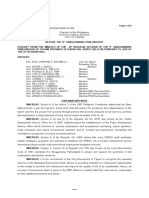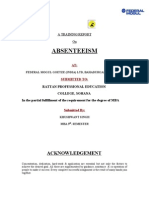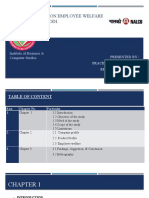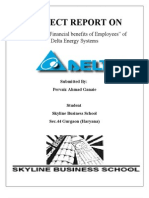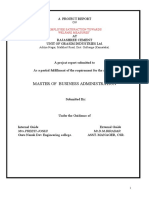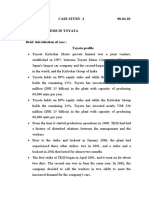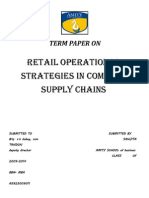Toyota Case Study
Toyota Case Study
Uploaded by
Sanjita TanDonCopyright:
Available Formats
Toyota Case Study
Toyota Case Study
Uploaded by
Sanjita TanDonOriginal Title
Copyright
Available Formats
Share this document
Did you find this document useful?
Is this content inappropriate?
Copyright:
Available Formats
Toyota Case Study
Toyota Case Study
Uploaded by
Sanjita TanDonCopyright:
Available Formats
The Toyota Problem
On January 08, 2006, Toyota Kirloskar Motor Private Limited (TKM) announced an indefinite lockout of its vehicle manufacturing plant at Bidadi located near Bangalore, Karnataka. The decision was taken following a strike, which had entered its third day, by the Toyota Kirloskar Motor Employees Union (Employee Union), the only company recognized union. The lockout notice stated that the strike was illegal as the Employee Union did not give the mandatory 14 day notice period as per Industrial Disputes Act, 1947. It also stated that the workers were indulging in violence and destruction. TKM was a joint venture, established in 1997, between Toyota Motor Corporation (Toyota), Japans largest car company and the second-largest car manufacturer in the world, and the Kirloskar Group of India. Toyota holds an 89% equity stake and while the Kirloskar Group holds the remaining 11%. Toyota has invested nearly US$ 336 million (INR 15 billion) in the plant with capacity of producing 60,000 units per year. Toyota manufactures its world famous cars like Corolla, Camry and Innova at the plant. The plant had a total workforce of 2,378 out of which around 1,550 employees belonged to the Employee Union. On January 06, 2006, the Employee Union went on strike with the demand to reinstate three dismissed employees, ten suspended employees, and improve the work conditions at the plant. These employees had been dismissed and suspended by the company, on disciplinary rounds, for attacking a supervisor and misconduct. TKM declared that it would not rehire nor reinstate those employees culminating in the strike and lockout. TKM made several serious allegations against the Employee Union. The company said that the striking workers were threatening to blowup LPG gas cylinders in the company premises, obstructing the outward movement of manufactured vehicles, illegally stopping production, and manhandling other workers, who were not part of the Employee Union, to strike. In response, the Employee Union said that three employees were dismissed because they were actively participating in trade union activities and the company wanted to suppress the trade union. They further said that working conditions at the plant were inhuman and slave like. They were often made to stretch their working hours without sufficient relaxation and compensation. The issue took a new turn when representatives from the management at TKM refused to attend a meeting before the Labor Commissioner on January 09, 2006 for resolving the dispute with the union. The company said that the atmosphere was not conductive for talks as the Employee Union was in a violent and agitated mood.
Though, the company appealed for two weeks time to appear before the Labor Commissioner so that situation could become stable, they were given time only till January 12, 2006. The Employee Union got support from various trade unions and demanded the intervention of the state government to help resolve the dispute in their favor. TKM continued with partial production of vehicles with the help of non-unionized workers and the management staff, who were specially trained for these kinds of emergencies. However, the companys output had fallen from 92 vehicles per day to 30 vehicles with an estimated production loss of around INR 700 million. The Company lifted the lockout on January 21, 2006 stating that it was responding to the request from workers who eager to return to work. The workers were required to sign a good conduct undertaking to maintain discipline and ensure full production. The Employee Union relented and withdrew their strike following a Government Order on January 21, 2006, which was against the strike and referred the issue to the third Additional Labor Court. However, the union said that they would not sign the good conduct declaration specified by TKM. The unrest had other ramifications as the Toyota spokesperson said that the company would rethink its recent decision to build a second car manufacturing plant in the state. It was also felt that this incident would seriously affect the Karnataka Governments efforts in trying to attract Volkswagen to establish a vehicle manufacturing plant in the state. This was the second dispute involving a Japanese vehicle manufacturer and trade unions in India. Earlier in July 2005, workers of Honda Motor & Scooters India Limited had a violent clash with the police at Gurgaon, near New Delhi, resulting in a revenue loss of around INR 1.25 billion for the company. This recent rise in trade union activism resulting in violence and business loss has attracted the attention of the national and international media. With around US$ 2 billion equity investment since 1991, Japan was the fourth largest investor in India. During the Honda incident, the Japanese ambassador in India had stated that these kinds of incidents would show India in poor light.
You might also like
- Compensation Management ProjectDocument40 pagesCompensation Management ProjectShaista Iqbal81% (31)
- IH AnsweresDocument29 pagesIH AnsweresAsif GhaziNo ratings yet
- A Study On Employee Turnover in IT Sector - InfosysDocument5 pagesA Study On Employee Turnover in IT Sector - InfosysVikram MayuriNo ratings yet
- Case Study On Strike at Maruti Suzuki IndiaDocument13 pagesCase Study On Strike at Maruti Suzuki IndiaSuman Gadwal93% (14)
- Barangay Employment DeskDocument6 pagesBarangay Employment DeskJayson De Lemon100% (2)
- Sushma Industries: The Gordian Knot of Compensation DesignDocument7 pagesSushma Industries: The Gordian Knot of Compensation DesignBCom Hons100% (1)
- IR Problems at Toyota Kirloskar Motors Pvt. LTD.: A Case Study OnDocument13 pagesIR Problems at Toyota Kirloskar Motors Pvt. LTD.: A Case Study Onkavitasawant8267% (3)
- Industrial Relations BHEL IndiaDocument25 pagesIndustrial Relations BHEL IndiaAshish NirmalNo ratings yet
- Industrial Disputes - A Case of Maruti ManesarDocument11 pagesIndustrial Disputes - A Case of Maruti ManesarArakanshu SinghNo ratings yet
- Maruti Case StudyDocument9 pagesMaruti Case StudyKumar Raghav Maurya100% (6)
- MRF Limited Project Work On Employee BenefitsDocument30 pagesMRF Limited Project Work On Employee BenefitsRajeshShindhe83% (6)
- fINAL Honda Motorcycles and Scooters India LTD (HMSI)Document45 pagesfINAL Honda Motorcycles and Scooters India LTD (HMSI)Kaushik Mohapatra100% (4)
- Key Learnings From MR - Mehta DilemmaDocument1 pageKey Learnings From MR - Mehta Dilemmaraghav94g0% (1)
- TCS Organization StructureDocument34 pagesTCS Organization Structureurmi_patel22No ratings yet
- Labor Unrest at ToyotaDocument1 pageLabor Unrest at Toyotaaki001100% (1)
- Toyota CaseDocument3 pagesToyota CasegreatisacNo ratings yet
- Final Presentation1Document16 pagesFinal Presentation1Suvi PawarNo ratings yet
- Case Study On Strike at Maruti Suzuki IndiaDocument13 pagesCase Study On Strike at Maruti Suzuki IndiaAnkit Ranjan50% (2)
- Labour Unrest at Honda MotorcyclesDocument7 pagesLabour Unrest at Honda MotorcyclesMayuri Das0% (1)
- Labour Unrest Edited. 2Document20 pagesLabour Unrest Edited. 2Aakash Saxena100% (1)
- Group 7 Sec A Session 4 TescoDocument11 pagesGroup 7 Sec A Session 4 TescoRaj AnkitNo ratings yet
- Challenges Faced by HR Team in TCSDocument16 pagesChallenges Faced by HR Team in TCSNavin KumarNo ratings yet
- Maruti Suzuki Case StudyDocument3 pagesMaruti Suzuki Case StudyShivam Gupta80% (5)
- Case Study - Whether An Employee or WorkerDocument6 pagesCase Study - Whether An Employee or WorkerRenei Karyll BaacoNo ratings yet
- Absenteeism iNTERNSHIP REPORTDocument71 pagesAbsenteeism iNTERNSHIP REPORTmain_hoo_naa0100% (4)
- Bata Internship Report 1Document30 pagesBata Internship Report 1Muktadir MinexNo ratings yet
- Honda CaseDocument4 pagesHonda CaseRehan KhanNo ratings yet
- Report 123Document39 pagesReport 123Akansha Sen0% (1)
- A Project Report On Employee Welfare in Nalco, Damanjodi.: Institute of Business & Computer StudiesDocument16 pagesA Project Report On Employee Welfare in Nalco, Damanjodi.: Institute of Business & Computer StudiesPrachi Mohanty - 136No ratings yet
- Philips IndiaDocument4 pagesPhilips Indiapriyanshu jain jainNo ratings yet
- HR Practices in SBI 2Document12 pagesHR Practices in SBI 2Abhishek SinghNo ratings yet
- Bata Case Study SolutionDocument5 pagesBata Case Study SolutionMuhammad UmerNo ratings yet
- Synopsis On Employee Satisfaction Bhel NewDocument6 pagesSynopsis On Employee Satisfaction Bhel NewArchi guptaNo ratings yet
- Case SummaryDocument7 pagesCase SummaryManjurul Haque100% (1)
- Case Study MRFDocument2 pagesCase Study MRFsrivastavasumita100% (1)
- Human Resource Plaining A Challenge PDFDocument5 pagesHuman Resource Plaining A Challenge PDFSriram Thwar0% (5)
- Ir Hero HondaDocument15 pagesIr Hero HondaRama ChakravortyNo ratings yet
- 1.2 Scope of The StudyDocument56 pages1.2 Scope of The StudyArif Mohammad67% (3)
- NEW Organizational Climate Dhanalakshmi Sugar MillDocument86 pagesNEW Organizational Climate Dhanalakshmi Sugar MillKrithi SelvaNo ratings yet
- Web of Rules and IdeologyDocument5 pagesWeb of Rules and IdeologyAisyah Sajat100% (1)
- Industrial RelatiionsDocument90 pagesIndustrial RelatiionsAnonymous MhCdtwxQINo ratings yet
- Case Study: Hero Honda: Made By:-SIMRAN GARG-0181MBA117 Kashish Madaan - 0181mba086Document20 pagesCase Study: Hero Honda: Made By:-SIMRAN GARG-0181MBA117 Kashish Madaan - 0181mba086Simran GargNo ratings yet
- High Attrition Rate in InfosysDocument9 pagesHigh Attrition Rate in InfosysThakur Sahil Narayan100% (1)
- A Study On Employee Relationship Management With Special Reference To DDCMPU KrishnagiriDocument25 pagesA Study On Employee Relationship Management With Special Reference To DDCMPU KrishnagiriCHEIF EDITORNo ratings yet
- MRF (The Details On HR Pespectives) HR Practices and ProgrammesDocument6 pagesMRF (The Details On HR Pespectives) HR Practices and ProgrammesRiyas Parakkattil67% (3)
- Bata Case StudyDocument2 pagesBata Case StudyKreator's Blog86% (7)
- Industrial Relations Review of LiteratureDocument25 pagesIndustrial Relations Review of LiteraturekodalipragathiNo ratings yet
- A Study On Human Resource Development IN Rinl Steel Plant VisakhapatnamDocument87 pagesA Study On Human Resource Development IN Rinl Steel Plant Visakhapatnamdinesh beharaNo ratings yet
- Project Report On: A Study On "Financial Benefits of Employees" of Delta Energy SystemsDocument56 pagesProject Report On: A Study On "Financial Benefits of Employees" of Delta Energy SystemsHarmeet singh81% (16)
- Organisational Culture of BhelDocument43 pagesOrganisational Culture of BhelYatin Narang100% (4)
- HR Report-Rajashri CementDocument75 pagesHR Report-Rajashri CementKumar RajadhyakshNo ratings yet
- Labor Unrest at Toyota IndiaDocument2 pagesLabor Unrest at Toyota IndiadyanirajNo ratings yet
- Labour Unrest at Toyota IndiaDocument2 pagesLabour Unrest at Toyota IndiaPriyanka KumarNo ratings yet
- Case Study - 2 08-04-20Document7 pagesCase Study - 2 08-04-20KanakaMaha LakshmiNo ratings yet
- On January 08Document1 pageOn January 08Yagna SriNo ratings yet
- Labour Unrest at ToyotaDocument2 pagesLabour Unrest at ToyotamnjbashNo ratings yet
- Case Study of Industrial Dispute ActDocument2 pagesCase Study of Industrial Dispute ActKaran GaurNo ratings yet
- ToyotaDocument4 pagesToyotasunny837No ratings yet
- Labour Unrest at ToyotaDocument9 pagesLabour Unrest at ToyotaNamratha ReddyNo ratings yet
- IR of TCLDocument2 pagesIR of TCLsoumyadeep_sahuNo ratings yet
- Toyota Motor CorporationDocument2 pagesToyota Motor CorporationSuhani AroraNo ratings yet
- Mohit Case AnalysisDocument17 pagesMohit Case AnalysisMayank Agarwal100% (1)
- Honda UnrestDocument6 pagesHonda UnrestAnonymous kayEII5NNo ratings yet
- BTQ FormDocument1 pageBTQ FormSanjita TanDonNo ratings yet
- Retail Operational Strategies in Complex Supply ChainsDocument12 pagesRetail Operational Strategies in Complex Supply ChainsSanjita TanDonNo ratings yet
- In V Ion: By:-Sanjita TandonDocument15 pagesIn V Ion: By:-Sanjita TandonSanjita TanDon100% (1)
- I. Balanced Scorecard BasicsDocument25 pagesI. Balanced Scorecard BasicsSanjita TanDonNo ratings yet
- Association of Southeast Asian NationsDocument7 pagesAssociation of Southeast Asian NationsSanjita TanDonNo ratings yet
- Cost Class If CationDocument24 pagesCost Class If CationSanjita TanDonNo ratings yet
- CV-Dyah Ayu PangestutiDocument1 pageCV-Dyah Ayu PangestutihrgakhiNo ratings yet
- Mgt269 - Business Communication (7) (Jobinterview)Document15 pagesMgt269 - Business Communication (7) (Jobinterview)Syaza AisyahNo ratings yet
- Employment Contract - LawyerDocument2 pagesEmployment Contract - LawyerChester Pryze Ibardolaza TabuenaNo ratings yet
- Department of Labor: ISH Registration Flier - 07Document9 pagesDepartment of Labor: ISH Registration Flier - 07USA_DepartmentOfLaborNo ratings yet
- 6 Dogberts Top Secret Management Handbook Harder Reading HumourDocument8 pages6 Dogberts Top Secret Management Handbook Harder Reading HumourPritish MohanNo ratings yet
- House Hearing, 114TH Congress - Legislative Branch Appropriations For 2016Document366 pagesHouse Hearing, 114TH Congress - Legislative Branch Appropriations For 2016Scribd Government DocsNo ratings yet
- Labor Economics Havard SyllabusDocument31 pagesLabor Economics Havard SyllabusjoydramblesNo ratings yet
- Assignment 1 TNDDocument4 pagesAssignment 1 TNDŠyȜd UŠmãn AłiNo ratings yet
- 2962745a-900e-4247-b22d-bd3d888254cfDocument9 pages2962745a-900e-4247-b22d-bd3d888254cfSwamy Dhas DhasNo ratings yet
- Serrano vs. Gallant Maritime ServicesDocument2 pagesSerrano vs. Gallant Maritime Serviceskaren igana100% (2)
- Plan de Auditoría RA - WESTFALIA-SA-F-GA-3-V1 CAFDocument12 pagesPlan de Auditoría RA - WESTFALIA-SA-F-GA-3-V1 CAFLuis DCNo ratings yet
- Serious Games Taxonomy 2008Document54 pagesSerious Games Taxonomy 2008James O'ReillyNo ratings yet
- Community Profile: CGSMS Form No.1-ADocument1 pageCommunity Profile: CGSMS Form No.1-AChosel S. PaguicanNo ratings yet
- AutobiographyDocument41 pagesAutobiographyapi-3093093820% (1)
- RA Nurse ZAMBO June2019 PDFDocument50 pagesRA Nurse ZAMBO June2019 PDFPhilBoardResultsNo ratings yet
- HBMN231 1 Jul Dec2024 SA2 LMG V.5 01072024Document10 pagesHBMN231 1 Jul Dec2024 SA2 LMG V.5 01072024candice.jenneker623No ratings yet
- Maintenance Management and Maintenance Services Offered byDocument19 pagesMaintenance Management and Maintenance Services Offered byocchityaNo ratings yet
- Comprehensive Project Report Asbm UniversityDocument63 pagesComprehensive Project Report Asbm UniversityBaijayantimala GhadeiNo ratings yet
- Human Resource ManagementDocument34 pagesHuman Resource Managementnrp8409No ratings yet
- Chapter 1Document2 pagesChapter 1Janelle Khoo Pei XinNo ratings yet
- Maternity Benefit FormDocument6 pagesMaternity Benefit FormChott DesilvaNo ratings yet
- 8.time and WorkDocument2 pages8.time and WorksujaiNo ratings yet
- Employer Relationship - Recruitment and Placement - Week 2 LectureDocument6 pagesEmployer Relationship - Recruitment and Placement - Week 2 LectureKate Myrzel PauliteNo ratings yet
- Resume Ritika Garikipati 4yearsDocument2 pagesResume Ritika Garikipati 4yearsAstrids michelNo ratings yet
- OB Climate and Work EnvironmentDocument28 pagesOB Climate and Work Environmentalishbaawan981100% (1)
- BRPAT00098400000014524 NewDocument6 pagesBRPAT00098400000014524 NewWorld WebNo ratings yet
- Speech Pathology Cover LetterDocument6 pagesSpeech Pathology Cover Letterbatesybataj3100% (2)
- 2013 Ipg Agency HandbookDocument33 pages2013 Ipg Agency HandbookAlexSouthernNo ratings yet




